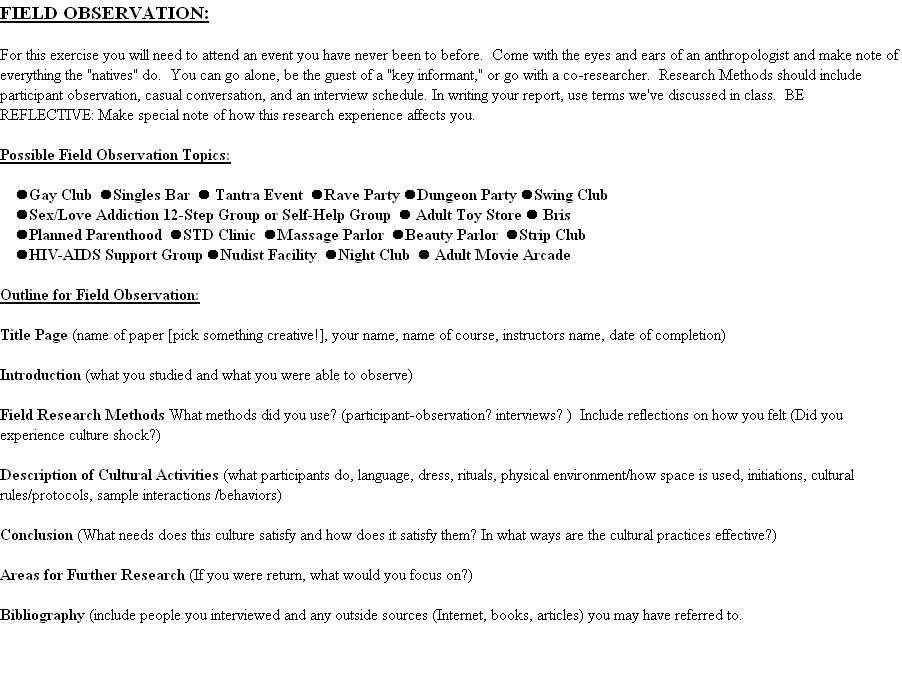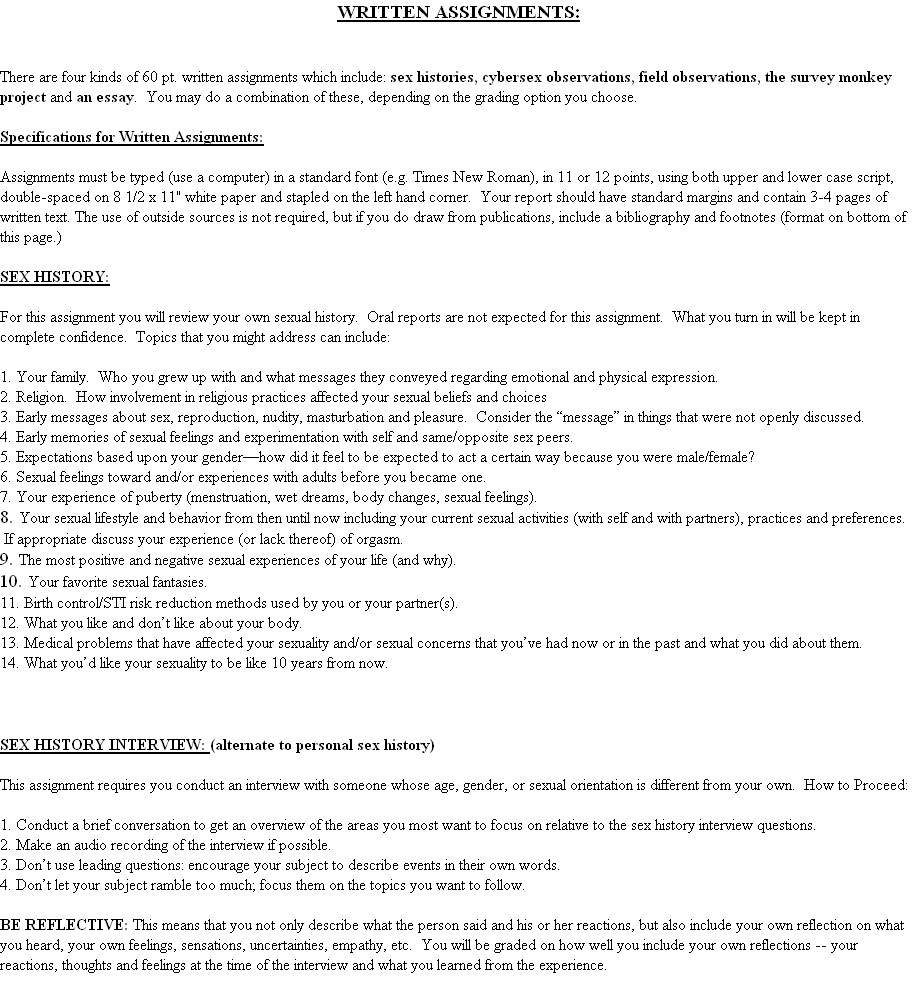
1. Title Page (pick something creative!)
2. Introduction/Statement of Problem/Issue
3. Discussion of Findings (the body of your essay-
5. Areas for Further Research (be creative!)
6. Bibliography (see format on bottom of this page)
Should Hermaphrodites have Genital Reconstruction Surgeries?
Should Genital Mutilations be Banned?
What does Love have to do with Sex?
Parallels between Human and Ape (e.g. chimp/bonobo) Sexualities
Swinging: Is it safe? Who participates and why?
Transgenderism: Is sexual reassignment surgery the answer?
Homosexuality: Ritual Expressions and Current Practice
Is Monogamy Natural? Why do Some Cultures allow Polygamy?
Mormon Polygamy: Should the U.S. government interfere?
How Has Marriage Changed Over the Years?
The Future of Marriage
Polyamory: Who Practices it and Why
Cyber Dating and Cyber Sex
Teen Sex and Teen Dating
Arranged Marriage: The Benefits and Liabilities
Sexual Initiations: A Cross-
Does Hooking Up Hurt Young Women/Young Men?
Who Practices Endogamy and Why?
Gay Marriage: Should it Be Legalized?
Single Mothers: Who Becomes One and Why?
The Adoption Triangle: Birth Mothers, Adopting Families and Adoptees
Who Cheats and Why?
How Female Breadwinners are Transforming Marriage
The Impact of New Media on Social and Sexual Relationships
Texting, Sexting and the Future of Intimacy
Are Long Term Relationships Still Possible?
Online Dating: Comparison Between Tinder and Shaadi.com (Indian Dating Site)
Please submit the link to your research site (as well as the site’s username and password) with your completed report. Class time will be allocated for developing a questionnaire, discussing data collection strategies, and assisting students with data analysis. To begin your questionnaire you might want to use the questions on this sample site: sample site.
Survey Monkey Research Project Outline:
1. Title Page
2. Introduction
3. Research Methodologies
4. Discussion of Findings (illustrate with data charts)
5. Conclusions
6. Areas for Further Research
6. Bibliography (see bottom of this page)
CYBERSEX OBSERVATION:
For this project you are to find one or more subjects who will allow you to observe them engaging the cybersex world via their phone, tablet or computer. Here you are to observe how they engage people and ideas. Depending on your subject’s comfort level you can either watch what they do silently or have them offer commentary on what they are doing and what needs it satisfies for them. Possible cybersex observations:
1. Tinder. Observe the choices your subject makes. If possible, engage in discussion while they are making their choices.
2. Dating Sites e.g. OKCupid, Plenty of Fish, Match.com, E-
3. Social Media Sites: Facebook, Snap Chat, Instagram, Twitter -
Topics to Consider:
Do they receive responses? What protocols follow?
How do the “block” people they are not interested in?
How do they extend “offers” to people they want more connection with?
Do they then send links to Instagram or Facebook?
What platforms do they chat on with potential dates?
What experiences have they had meeting in person e.g. single-
Texting and Sexting.
When they are focused on someone how often do they exchange texts?
What is the content of their texts?
Do the engage in the “disinhition” effect?
Do they exchange photos and/or selfies?
Outline for your report:
Title Page (name of paper [pick something creative!], your name, name of course, instructors name, date of completion)
Introduction (who you observed (basic information about your subject(s), e.g. age, gender, etc) and a brief overview of your findings.
Field Research Methods What methods did you use? (observations? interviews? ) Include reflections on how your subjects engage the cyber world differently than you do and/or differently from each other.
Description of Cybersex Cultural Activities (Discuss what you observed (re: mediums, sites, activities) as well as your subjects’ assessment of what cyber relating means to them. Are there cultural rules/protocols they follow? What are some sample interactions you observed?
Conclusion (What needs does this culture satisfy and how does it satisfy them? In
what ways are the cultural practices effective? Does cyber-
Areas for Further Research (If you were return, what other topics related to cybersex culture would you focus on?)
Bibliography (interview subjects and outside sources (Internet, books, articles; format on bottom of this page)
Things to Keep In Mind For Written Assignments
- When using a computer, back-
up your work on a thumb drive or on a cloud - Proofread! Read your paper aloud to catch awkward sentences.
- Use “spell check,” but remember the three forms: their / they’re / there …and two / to / too
- Spell alter and altar correctly!
- Leave one space after a comma.
- Spell out numbers under 11.
- Spell any number that is at the beginning of a sentence.
- A sentence needs a subject and a verb—otherwise it’s a fragment.
- Write in your own words! If you want to maintain the exact wording of another source, use quotation marks or single space and indent the copied section and then use footnotes.
- Don’t use words that you don’t understand.
- Avoid “run-
on- sentences,” by keeping your ideas focused. - Follow rules for proper hyphenation—divide words between syllables, making sure the second half begins with a consonant.
- “Keep punctuation marks inside of quotation marks.”
- Get help by turning in an early rough draft and/or using the campus writing center.
Bibliography Format:
*Alphabetize by author's last name, italicize publications, put quotes around articles and designate page numbers.
For a book:
Terray, Carl
2016 Tinder Town; New York: Monthly Review Press
For an article in a magazine, newspaper, or book:
Dalton, George
2014 "Burning Desires,” American Anthropologist No. 76 September 2014, p. 553.
For an oral communication (speech/interview):
Jackson, Miranda
2015 Personal Communication, Van Nuys, CA, October 10, 2015
For a television program:
Thomas, Stanley
2013 "Twosomes and Threesomes," Nova Series, PBS Television
For an Internet site:
Chappel, Clinton (Important to FIND the author and the full name of the site)
2013 “Hooking in San Francisco,” http://www.geocities.com/prostitution/SF, May 14, 2016
(date retrieved)
REFERENCES/FOOTNOTES:
For a direct quote: if it is four lines or more single space and indent, eg.
A man does not have full status in social life until he is married: has no
household of his own, and he is debarred from many privileges; hence
except for the physically and mentally handicapped, all mature Trobriands
marry (Symons, 1999:113)
Referring to an author’s idea, but not quoting them directly:
Leakey (2015) saw than bipedalism was a natural adaptation to a savanna environment where more could be seen by standing upright.
Referring to ideas of an author without using the author’s name in your text:
The advantages of an omnivorous diet are numerous, especially in that intense foraging becomes possible in a limited area (Franklin, 2016).
